More Adventures in Nest Protection
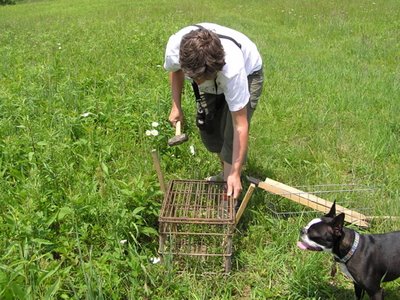 Zick, trying to tip the balance toward the underdog again. Photo by Phoebe Thompson.
Zick, trying to tip the balance toward the underdog again. Photo by Phoebe Thompson.This time, it's box turtles. For 13 years, I have gone out in the evenings, looking for box turtles laying their eggs in our meadow. I look in all the spots where I've found dug-out, ruined nests in the past. Boxies lay 3-5 eggs in a gourd-shaped hole in the ground. They lay in early June in southern Ohio, and the eggs incubate with the warmth of the sun, for three months or more. The baby turtles, about the size of a quarter, hatch out in September and October. Usually, they dig their way to the surface and go their own way. But sometimes they hatch, and just stay in the nest until the following spring!
So I look for female turtles laying eggs, and I've found a few, always on June evenings. But as luck would have it, the nests they've started weren't completed--they hit a rock, or a root, and had to move on. By then, I'd moved on, too; it got dark, and I never knew where they finally laid their eggs. But the coons and possums and skunks and snakes knew, and I find many dug-out nests every summer, the white, curled shells scattered like so many candy wrappers, and it breaks my heart every time.
Here's the female I found on the evening of June 6, laying her eggs. Her right leg is deep in the nest hole. She alternates legs, scooping out the nest chamber. She works all night, sometimes two nights, to create the chamber and lay her eggs. She's so vulnerable, it scares me.
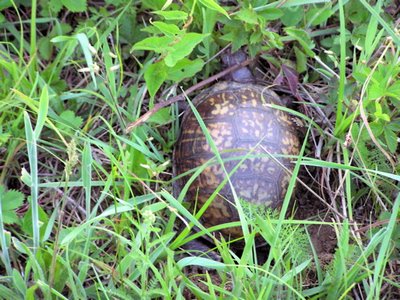 Chet found another female laying that evening, but she hit a root and moved on to dig another chamber in an unknown place. The next morning, Phoebe and I went out, breathless with anticipation, and found the successful nest beautifully covered over and concealed.
Chet found another female laying that evening, but she hit a root and moved on to dig another chamber in an unknown place. The next morning, Phoebe and I went out, breathless with anticipation, and found the successful nest beautifully covered over and concealed.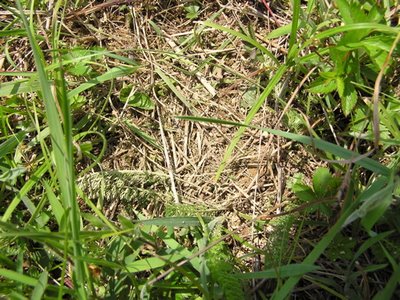 I dug down carefully, just until I hit an egg, to be sure that this was a successful nest.
I dug down carefully, just until I hit an egg, to be sure that this was a successful nest.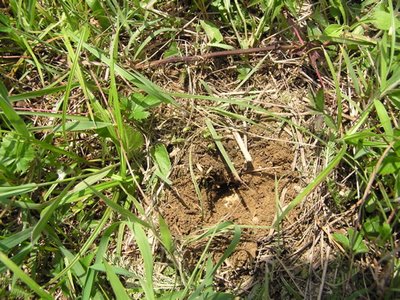 The egg is leathery, easily dented, almost squishy when it's fresh. Beautiful!
The egg is leathery, easily dented, almost squishy when it's fresh. Beautiful!I covered the nest back up and set about protecting it. An iron milk crate would help with the coons, skunks, and opossums. Because I found a nest in Connecticut, protected it with a bicycle basket weighted with cinder blocks, and had three attempts by coons to dig it out, I knew I couldn't fool around. This same nest hatched out on an October night. I was returning, 10:30 at night, in a driving cold rain, from speaking at the Yale School of Forestry. I thought, "You know, that turtle nest really ought to have hatched by now. I'm going to check it." I got a flashlight out of the car, shone it on the caged nest, and was flabbergasted to see a 5' black rat snake just entering the cage--in the dead of night, in a pouring rain--and a baby box turtle just poking its head out for the first time! I caught the snake and flung it as far as I could into the woods, ran and got a joint compound bucket, weighted it with a boulder, and put it over the nest for the night. The next morning, five baby turtles were scurrying around under the bucket! Their cast eggshells smelled fishy, and I imagine that's what had attracted the snake. I felt as if someone had tapped me on the shoulder and said, "You're needed here." That's a beautiful feeling.
So. I was not about to let any predator get this first precious Ohio nest. So I made a cage within a cage. The small-mesh copper basket (found in the home organizing section of Lowe's) is for the black rat snakes. The iron milk crate is for the furry fiends. That cage ain't goin' nowhere, in Southern Ohio parlance. The only thing this contraption couldn't stop is a bear. Which, in time, may be something I have to contend with. For now, coons and rat snakes are more than enough. Baker approves the cage.
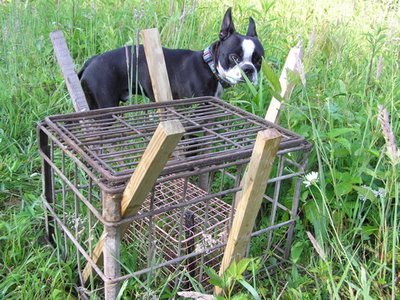
Now, to sit back and wait three months. That's OK. I'm waiting anyway. It's good to know those eggs are cooking slowly, under the ground, making more box turtles.
Obviously, my Type A tendencies made me try just one more time to make this post. Slow and steady wins the race.






<< Home